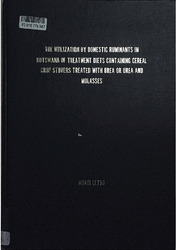The utilization by domestic ruminants in Botswana of treatment diets containing cereal crop stovers treated with urea or urea and molasses
Abstract
The studies were aimed at examining the effects of treatment with urea or urea and molasses on the physical and chemical composition of stovers of sorghum, maize and millet and assessing the potential of these treated cereal crop stovers as additional feed for domestic ruminants in Botswana. The trials were carried out at Sebele, Botswana College of Agriculture (BCA), Botswana. Sebele is situated at 24° 33'S and 25° 57'E and is at an altitude of 994 m above sea level. Cereal crop stovers were ground in a hammer mill and treated with10 g urea/kg stover (Tl), 25 g urea/kg stover (T2) or 10 g urea + 10 g molasses/kg stover (T3) for 3 weeks. The experimental design for the treatment of the cereal crop stovers was a 3 x 4 completely randomized factorial design [3 cereal crop stovers and 3 treatment methods (Tl, T2, T3) plus untreated]. Samples of cereal crop stovers untreated or treated with Tl, T2 or T3 w’ere obtained and analysed for dry matter (DM), organic matter (OM), crude protein (CP), neutral detergent fibre (NDF), acid detergent fibre (ADF), acid detergent lignin (ADL) and in vitro DM digestibility (IVDMD). The physical changes on the cereal crop stovers due to treatments were noted. Six steers, four of which were fitted with rumen cannulae, and six goats and six sheep were used in a crossover experiment to evaluate the utilisation of treatment diets containing stovers of sorghum, maize and millet treated with Tl, T2 or T3. The animals were kept in individual pens and fed a basal diet of veld grass hay plus a commercially available feed, namely Pen-feed. Each animal had unrestricted access to water 11 and a mineral lick and were adapted to the respective treatment diets for 14 days, followed by 7-day sampling periods The data collected included the feed intake and digestibility coefficients of DM, OM, CP, NDF and ADF. Data were also obtained on metabolisable energy (ME) intake, average daily gains and the pH and ammonia concentration of rumen fluid.Treatment with Tl, T2 and T3 increased the CP, NDF, ADF, ADL and IVDMD of the cereal crop stovers. The mean CP (g/kg DM) of cereal crop stovers increased from 69.75 (untreated) to 99.94, 112.63, and 110.50 when treated with Tl, T2 and T3 respectively. Significant improvements in the total intake of DM and CP by steers compared to the Control diet were observed when feeding cereal crop stovers treated with T2 and T3. The improvements in the intake and nutrient digestibility coefficients when providing some treatment diets containing the treated stovers are comparable to those obtained when offering lucerne hay which implies that these treatment diets may be suitable replacements for lucerne hay. However, the treatment diets did not significantly improve the average daily gain and metabolic body weights of the steers, goats and sheep. Therefore, treatment diets containing stovers of sorghum, maize or millet treated with Tl, T2 or T3 used in the present study are recommended for maintenance rather than production purposes.
Collections
- Theses and Dissertations [133]

